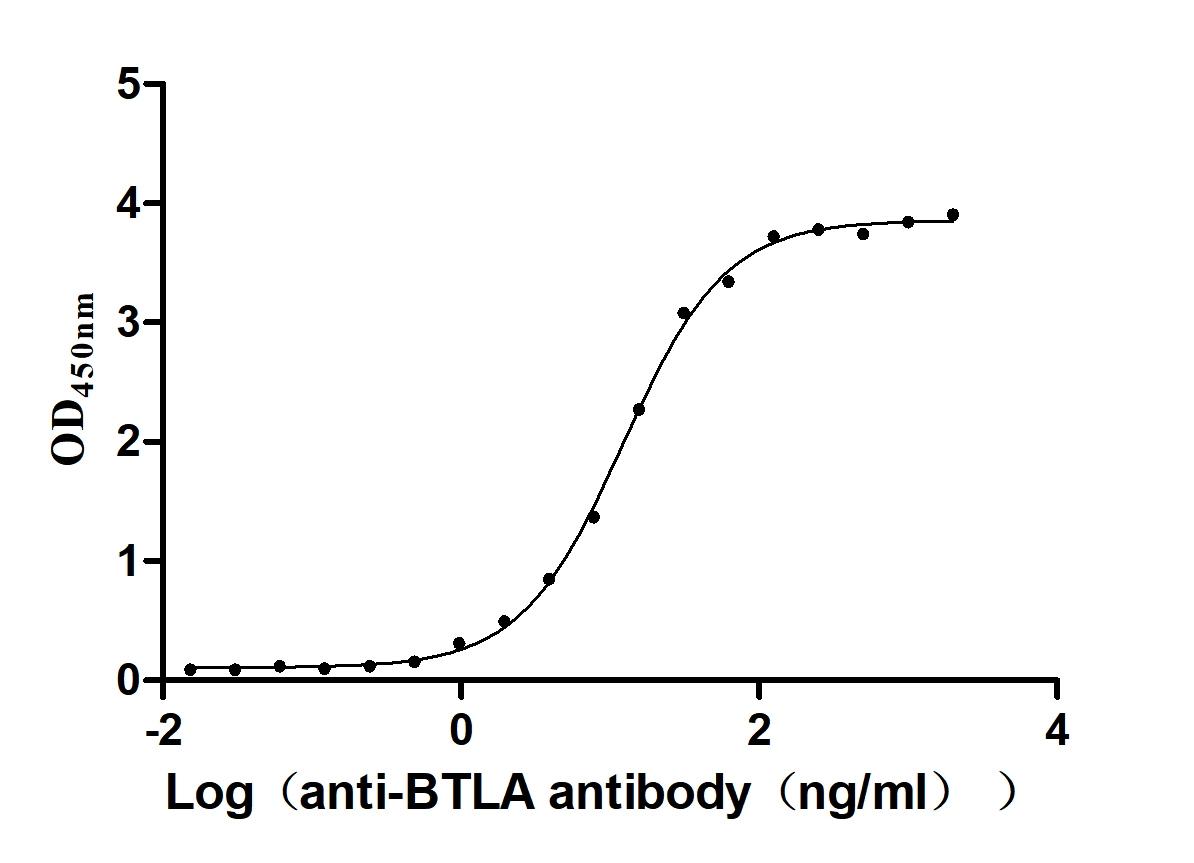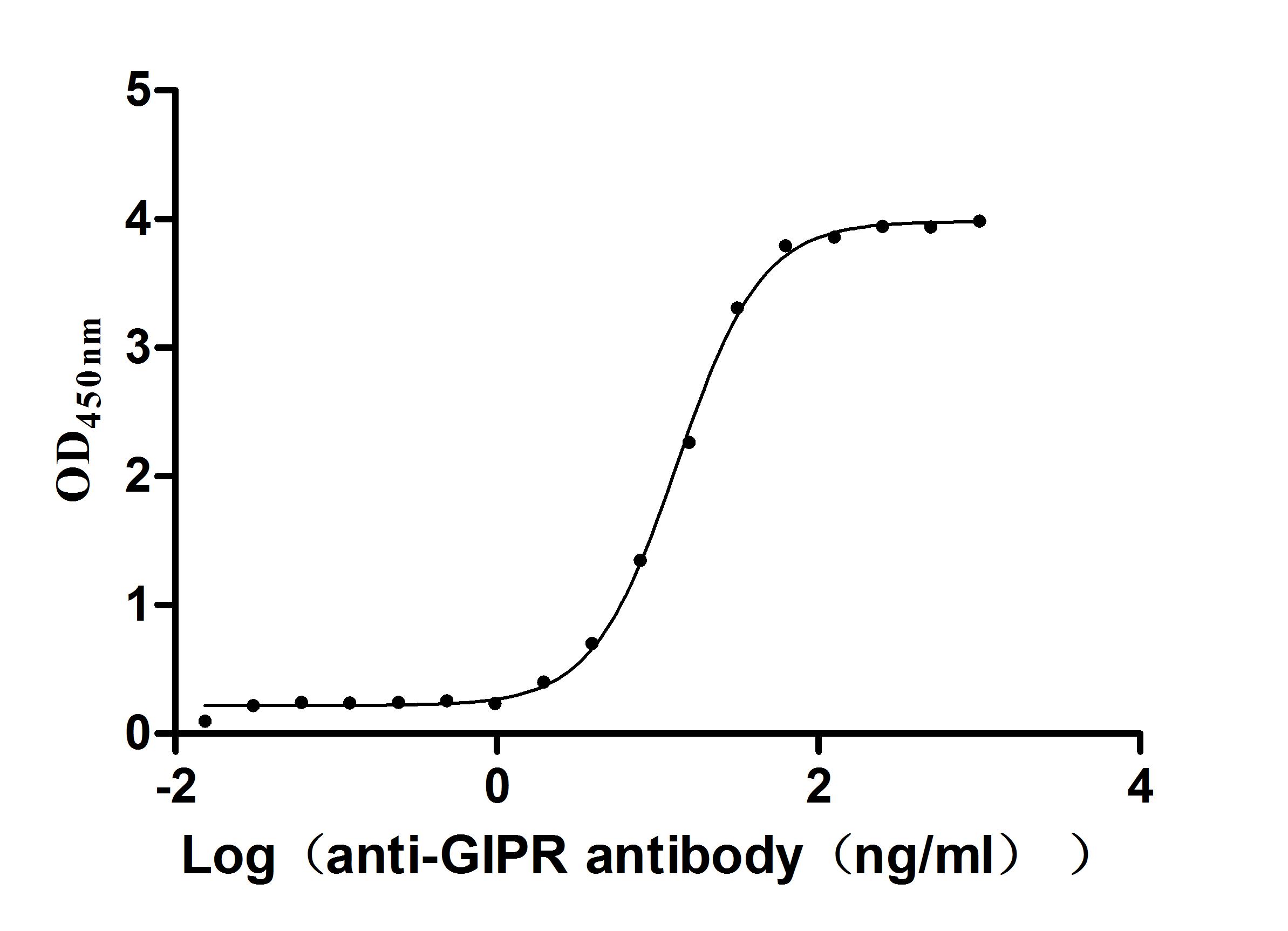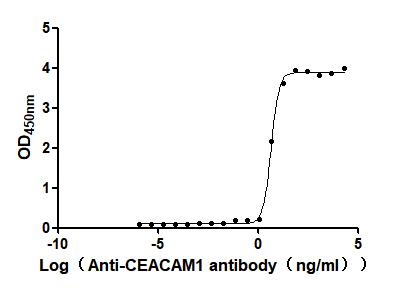Recombinant Human immunodeficiency virus type 1 group M subtype B Protein Tat (tat)
-
中文名稱:Recombinant Human immunodeficiency virus type 1 group M subtype B Protein Tat(tat)
-
貨號:CSB-YP361317HKP
-
規格:
-
來源:Yeast
-
其他:
-
中文名稱:Recombinant Human immunodeficiency virus type 1 group M subtype B Protein Tat(tat)
-
貨號:CSB-EP361317HKP
-
規格:
-
來源:E.coli
-
其他:
-
中文名稱:Recombinant Human immunodeficiency virus type 1 group M subtype B Protein Tat(tat)
-
貨號:CSB-EP361317HKP-B
-
規格:
-
來源:E.coli
-
共軛:Avi-tag Biotinylated
E. coli biotin ligase (BirA) is highly specific in covalently attaching biotin to the 15 amino acid AviTag peptide. This recombinant protein was biotinylated in vivo by AviTag-BirA technology, which method is BriA catalyzes amide linkage between the biotin and the specific lysine of the AviTag.
-
其他:
-
中文名稱:Recombinant Human immunodeficiency virus type 1 group M subtype B Protein Tat(tat)
-
貨號:CSB-BP361317HKP
-
規格:
-
來源:Baculovirus
-
其他:
-
中文名稱:Recombinant Human immunodeficiency virus type 1 group M subtype B Protein Tat(tat)
-
貨號:CSB-MP361317HKP
-
規格:
-
來源:Mammalian cell
-
其他:
產品詳情
-
純度:>85% (SDS-PAGE)
-
基因名:tat
-
Uniprot No.:
-
別名:tat; Protein Tat; Transactivating regulatory protein
-
種屬:Human immunodeficiency virus type 1 group M subtype B (isolate HXB2) (HIV-1)
-
蛋白長度:full length protein
-
表達區域:1-86
-
氨基酸序列MEPVDPRLEP WKHPGSQPKT ACTNCYCKKC CFHCQVCFIT KALGISYGRK KRRQRRRAHQ NSQTHQASLS KQPTSQPRGD PTGPKE
-
蛋白標簽:Tag?type?will?be?determined?during?the?manufacturing?process.
The tag type will be determined during production process. If you have specified tag type, please tell us and we will develop the specified tag preferentially. -
產品提供形式:Lyophilized powder
Note: We will preferentially ship the format that we have in stock, however, if you have any special requirement for the format, please remark your requirement when placing the order, we will prepare according to your demand. -
復溶:We recommend that this vial be briefly centrifuged prior to opening to bring the contents to the bottom. Please reconstitute protein in deionized sterile water to a concentration of 0.1-1.0 mg/mL.We recommend to add 5-50% of glycerol (final concentration) and aliquot for long-term storage at -20℃/-80℃. Our default final concentration of glycerol is 50%. Customers could use it as reference.
-
儲存條件:Store at -20°C/-80°C upon receipt, aliquoting is necessary for mutiple use. Avoid repeated freeze-thaw cycles.
-
保質期:The shelf life is related to many factors, storage state, buffer ingredients, storage temperature and the stability of the protein itself.
Generally, the shelf life of liquid form is 6 months at -20°C/-80°C. The shelf life of lyophilized form is 12 months at -20°C/-80°C. -
貨期:Delivery time may differ from different purchasing way or location, please kindly consult your local distributors for specific delivery time.Note: All of our proteins are default shipped with normal blue ice packs, if you request to ship with dry ice, please communicate with us in advance and extra fees will be charged.
-
注意事項:Repeated freezing and thawing is not recommended. Store working aliquots at 4°C for up to one week.
-
Datasheet :Please contact us to get it.
靶點詳情
-
功能:Nuclear transcriptional activator of viral gene expression, that is essential for viral transcription from the LTR promoter and replication. Acts as a sequence-specific molecular adapter, directing components of the cellular transcription machinery to the viral RNA to promote processive transcription elongation by the RNA polymerase II (RNA pol II) complex, thereby increasing the level of full-length transcripts. In the absence of Tat, the RNA Pol II generates short or non-processive transcripts that terminate at approximately 60 bp from the initiation site. Tat associates with the CCNT1/cyclin-T1 component of the P-TEFb complex (CDK9 and CCNT1), which promotes RNA chain elongation. This binding increases Tat's affinity for a hairpin structure at the 5'-end of all nascent viral mRNAs referred to as the transactivation responsive RNA element (TAR RNA) and allows Tat/P-TEFb complex to bind cooperatively to TAR RNA. The CDK9 component of P-TEFb and other Tat-activated kinases hyperphosphorylate the C-terminus of RNA Pol II that becomes stabilized and much more processive. Other factors such as HTATSF1/Tat-SF1, SUPT5H/SPT5, and HTATIP2 are also important for Tat's function. Besides its effect on RNA Pol II processivity, Tat induces chromatin remodeling of proviral genes by recruiting the histone acetyltransferases (HATs) CREBBP, EP300 and PCAF to the chromatin. This also contributes to the increase in proviral transcription rate, especially when the provirus integrates in transcriptionally silent region of the host genome. To ensure maximal activation of the LTR, Tat mediates nuclear translocation of NF-kappa-B by interacting with host RELA. Through its interaction with host TBP, Tat may also modulate transcription initiation. Tat can reactivate a latently infected cell by penetrating in it and transactivating its LTR promoter. In the cytoplasm, Tat is thought to act as a translational activator of HIV-1 mRNAs.; Extracellular circulating Tat can be endocytosed by surrounding uninfected cells via the binding to several surface receptors such as CD26, CXCR4, heparan sulfate proteoglycans (HSPG) or LDLR. Neurons are rarely infected, but they internalize Tat via their LDLR. Through its interaction with nuclear HATs, Tat is potentially able to control the acetylation-dependent cellular gene expression. Modulates the expression of many cellular genes involved in cell survival, proliferation or in coding for cytokines or cytokine receptors. Tat plays a role in T-cell and neurons apoptosis. Tat induced neurotoxicity and apoptosis probably contribute to neuroAIDS. Circulating Tat also acts as a chemokine-like and/or growth factor-like molecule that binds to specific receptors on the surface of the cells, affecting many cellular pathways. In the vascular system, Tat binds to ITGAV/ITGB3 and ITGA5/ITGB1 integrins dimers at the surface of endothelial cells and competes with bFGF for heparin-binding sites, leading to an excess of soluble bFGF.
-
基因功能參考文獻:
- PKC-delta isoform plays a crucial role in Tat-TLR4 signaling pathway to activate NF-kappaB and CXCL8 production. PMID: 28539656
- Cyclophilin A is required for HIV-1 Tat palmitoylation . PMID: 29884859
- HIV-1 Tat:nuclear localisation signal/cell penetrating peptide is able to form a stable and direct interaction with the classical nuclear import receptor importin-alpha. PMID: 28490747
- TAT expression and methamphetamine exposure both independently improved visual discrimination learning. TAT expression improved early phase reversal learning, at the expense of late phase reversal learning. TAT expression was also associated with increased dopamine transporter levels in the caudate putamen. Combined TAT expression and methamphetamine exposure did not induce significant learning deficits. PMID: 29709610
- These data show that human macrophages infected with human immunodeficiency virus-1 show an increased expression of TREM-1. In parallel, direct exposure to the human immunodeficiency virus-1-related proteins Tat or gp120 induces TREM-1 expression in macrophages and confers anti-apoptotic attributes. PMID: 28181540
- NRON Long noncoding RNA potently suppresses the viral transcription by decreasing the cellular abundance of viral transactivator protein Tat. PMID: 27291871
- Results show that exposure of astrocytes to cocaine and HIV-Tat significantly decreases LXRbeta levels, downstream signaling and bioavailability of cholesterol; uncover novel alterations in a bioenergetic pathway in astrocytes exposed to cocaine and the HIV protein Tat. Results from these studies point to a new pathway in the CNS that may contribute to HIV-associated neurocognitive disorders in HIV+ cocaine user indivi... PMID: 29330881
- In this present work, the authors identify and characterize a transcription factor i.e. HIC1, which physically interacts with both Bcl11b/CTIP2 and HMGA1 to co-regulate specific subsets of cellular genes and the HIV-1 tat gene. PMID: 27725726
- Results show that Tat-induced inhibition of dopamine transport is regulated by histidine547 on hDAT. PMID: 27966610
- Therefore, functionally, unintegrated HIV DNA (uDNA)-derived Tat (uTat) antagonizes uDNA minichromatin repression to maintain persistent viral transcription in macrophages. uTat-mediated viral persistence may establish a viral reservoir in macrophages where uDNA were found to persist. PMID: 29549786
- TAR RNA stabilizes Tat as unfolded, but prevents it from misfolding, and maintaining its folding competence for interaction with multiple host factors toward its transactivation. PMID: 28418268
- This combined computational-experimental study demonstrates that histidine-547 (H547) of human DAT plays a crucial role in the DAT-HIV-1 Tat binding and dopamine uptake by DAT. PMID: 27250920
- Curcumin also decreased Tat mediated LTR promoter transactivation and inhibited virus production from HIV-1 infected cells. Taken together our study reveals a novel observation that curcumin causes potent degradation of Tat which may be one of the major mechanisms behind its anti HIV activity PMID: 27283735
- Tat triggers a Ca2+ signaling cascade in Nucleus Accumbens medium spiny neurons expressing Dopamine-1-like dopamine receptors leading to neuronal depolarization. PMID: 28623807
- Study shows that HIV-1 Tat-induced expression of chemokines via a positive feedback loop between HDAC6, NADPH oxidase and reactive oxygen species in astrocytes. PMID: 28499252
- the Ras signaling pathway is involved in HIV-1 Tat-induced changes in ZO-1 and NEP. PMID: 28553432
- Results demonstrated that HIV-1 protein Tat induces oligodendrocyte (Ol)/myelin injury by enhancing outward K+ current conducted by a voltage-gated K+ channel KV1.3 by using specific KV1.3 antagonists and siRNA knockdown of KV1.3 gene. This is the first demonstration that Tat targets at Ol KV1.3 channels by direct protein-protein interaction and interruption of channel phosphorylation/de phosphorylation processes. PMID: 27816768
- mu-opioid-receptor (MOR)-mediated G-protein activation was determined in neuroAIDS-relevant forebrain regions of transgenic mice with inducible central nervous system expression of HIV-1 Tat. Results show that exposure to an HIV protein can change the intrinsic response of the MOR to selective or therapeutically-relevant agonists, possibly via a mechanism involving altered expression and/or function of beta-arrestin-2. PMID: 26845176
- These findings identify a novel role for HIV-1 TAR in the absence of Tat, involving the interference with host cellular immune responses by targeting 7SK RNA-mediated gene expression and P-TEFb inactivation. PMID: 29037489
- HIV-1 Tat causes cognitive deficits and selective loss of parvalbumin, somatostatin, and neuronal nitric oxide synthase expressing hippocampal CA1 interneuron subpopulations. PMID: 27178324
- these results show a significant fraction of Tat is secreted and present in the form of exosomes and may contribute to the stability of extracellular Tat and broaden the spectrum of its target cells. PMID: 27173397
- The TAR central loop contacts the CycT1 Tat-TAR recognition motif (TRM) and the second Tat Zn(2+)-binding loop. Hydrogen-deuterium exchange (HDX) shows that AFF4 helix 2 is stabilized in the TAR complex despite not touching the RNA, explaining how it enhances TAR binding to the SEC 50-fold. PMID: 27731797
- Tat significantly impacts bioenergetics and autophagy resulting in dysregulation of cardiomyocyte health and homeostasis. PMID: 28493473
- a mechanistic link between UTX-1 and enhanced HIV-1 replication PMID: 27671333
- Data show that the HIV transactivator of transcription (Tat) protein manipulates the intrinsic toggling of HIV's promoter, the long terminal repeat (LTR), to generate bimodal ON-OFF expression and that transcriptional positive feedback from Tat shifts and expands the regime of LTR bimodality. PMID: 29045398
- developed Jurkat cells with stable expression of hsa-miR-21 or hsa-miR-222 and observed a similar pattern to Jurkat-Tat101 in resistance to FasL-mediated apoptosis, cell cycle arrest in G2/M and altered cell morphology PMID: 28968466
- Study showed that lysine mutations modulate the subcellular localization of Tat, and Tat transactivation activity is exquisitely regulated by lysine acetylation. Findings suggest that Tat may regulate diverse cellular activities through binding to different proteins and that the acetylation of distinct lysine residues in Tat may modulate its interaction with various partners. PMID: 23826228
- HIV and Tat inhibit LPS-induced IL-27 production in human macrophages via distinct mechanisms: Tat through the inhibition of cIAP-1-TRAF-6 and subsequent inhibition of PI3K and p38 MAPKs, whereas HIV through the inhibition of p38 MAPK activation. PMID: 28698313
- FoxO1 and FoxO4 antagonize Tat-mediated transactivation of HIV-1 promoter through the repression of Tat protein expression. PMID: 28699853
- Blockage of autophagy enhanced Tat-induced HIV-1 transactivation in TZM-bl cells. Moreover, Tat activated the Akt/mTOR and inhibited AMPK signaling pathway that was related to its up-regulation of PKM2 expression. PMID: 28583828
- TAR RNAs are cleaved by Dicer and processing is stimulated by the viral Tat protein. PMID: 26984525
- Tat exploited the cellular HDM2 (human double minute 2 protein) ubiquitin ligase to accelerate IRF-1 proteasome-mediated degradation, resulting in a quenching of IRF-1 transcriptional activity during HIV-1 infection. PMID: 27795392
- It was established in this report that interactions between PACT, ADAR1 and HIV-1-encoded Tat protein diminish the activation of PKR in response to HIV-1 infection. PMID: 28167698
- Data suggest that HIV-1 (human immunodeficiency virus type 1) Tat gene product is stabilized by host cell deubiquitinase USP7, leading to enhanced viral production; HIV-1 in turn up-regulates the USP7 protein expression in human T-lymphocytes. PMID: 28280111
- Enhanced Immune Responses against HIV-1 with Adenovector (Gag and Tat) Prime/Protein Boost Regimen and GM-CSF Injection.( PMID: 27917627
- Tat and Abeta aggregates in complex synergistically induced neurotoxicity both in vitro and in animal models. PMID: 28218748
- Tat-induced lysosomal exocytosis was astrocyte-specific and required GFAP expression and was mediated by ER stress. PMID: 27609518
- Tat expression or GFAP expression led to formation of GFAP aggregates and induction of unfolded protein response (UPR) and endoplasmic reticulum (ER) stress in astrocytes. PMID: 27609520
- These findings show ABIN1 as an intrinsic suppressor of HIV-1 mRNA transcription by regulating the ubiquitination of Tat. PMID: 28193275
- These findings underscore the role of KMT7 as an important monomethyltransferase regulating HIV transcription through Tat. PMID: 27235396
- HIV-1 Tat protein leads to the engagement of both the MyD88 and TRIF pathways and to the activation of PKC-betaII, MAP kinase, and NF-kappaB signaling to induce the production of TNF-alpha and IL-10, two cytokines strongly implicated in the chronic activation and dysregulation of the immune system during HIV-1 infection. PMID: 27053552
- Differences in stability between B-Tat and C-Tat result in differences in transactivation ability. PMID: 27007880
- Quantitative measurement of the molecular interactions among Tat, CycT1 and CDK9 has showed that any third molecule enhances the binding between the other two molecules. These findings suggest that each component of the Tat:P-TEFb complex stabilizes the overall complex, thereby supporting the efficient transcriptional elongation during viral RNA synthesis. PMID: 27193293
- HIV-1 Tat protein enhances expression and function of BCRP. PMID: 26367065
- CIITA acts as a general restriction factor against HIV-1 not only in T cells but also in myeloid cells. PMID: 27089879
- HIV Tat precisely controls RNA polymerase II recruitment and pause release to fine-tune the initiation and elongation steps in target genes. PMID: 26488441
- The present study first reported the yeast expressed production of Tat-NGB-His and His-NGB-His, and then elucidated the transduction and neuroprotection of Tat-NGB-His on PC12 cell PMID: 26646387
- The authors found that the Tat protein only binds to and inhibits a fraction of the total cellular miRNAs. PMID: 27060080
- the expression of a Tat construct containing mutations in the basic region (49-57aa), which is responsible for the interaction with PKR, favored neither parasite growth nor IL-10 expression in infected macrophages. PMID: 26608746
- FGF-2, VEGF-A, and HIV-Tat, may affect the glomerular filtration barrier in HIV+ children through the induction of synergistic changes in Rho-A and Src activity PMID: 27097314
顯示更多
收起更多
-
亞細胞定位:Host nucleus, host nucleolus. Host cytoplasm. Secreted. Note=Probably localizes to both nuclear and nucleolar compartments. Nuclear localization is mediated through the interaction of the nuclear localization signal with importin KPNB1. Secretion occurs through a Golgi-independent pathway. Tat is released from infected cells to the extracellular space where it remains associated to the cell membrane, or is secreted into the cerebrospinal fluid and sera. Extracellular Tat can be endocytosed by surrounding uninfected cells via binding to several receptors depending on the cell type.
-
蛋白家族:Lentiviruses Tat family
-
數據庫鏈接:
KEGG: vg:155871
Most popular with customers
-
Recombinant Human Glypican-3 (GPC3) (G537R), partial (Active)
Express system: Mammalian cell
Species: Homo sapiens (Human)
-
Recombinant Human B- and T-lymphocyte attenuator(BTLA), partial (Active)
Express system: Mammalian cell
Species: Homo sapiens (Human)
-
Recombinant Macaca fascicularis Gastric inhibitory polypeptide receptor (GIPR), partial (Active)
Express system: yeast
Species: Macaca fascicularis (Crab-eating macaque) (Cynomolgus monkey)
-
Express system: Mammalian cell
Species: Homo sapiens (Human)
-
Recombinant Human C-C chemokine receptor type 5 (CCR5)-VLPs (Active)
Express system: Mammalian cell
Species: Homo sapiens (Human)


-AC1.jpg)













